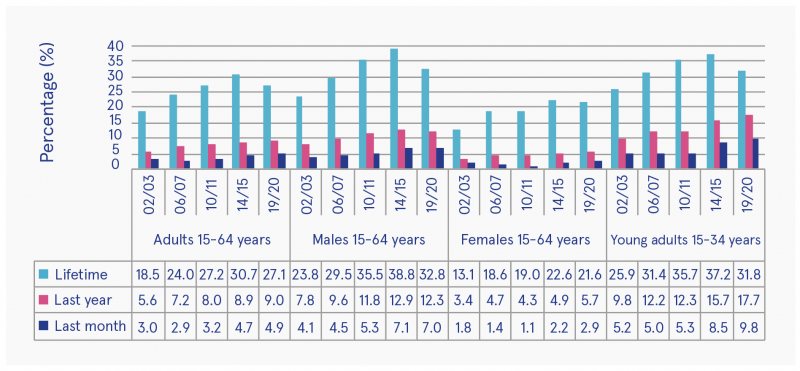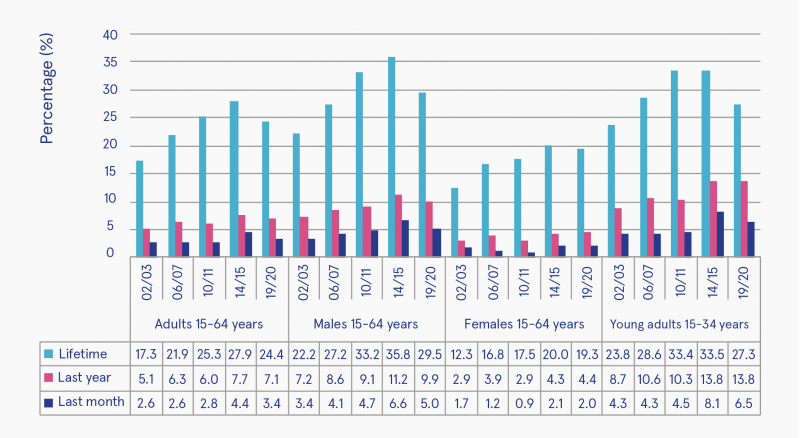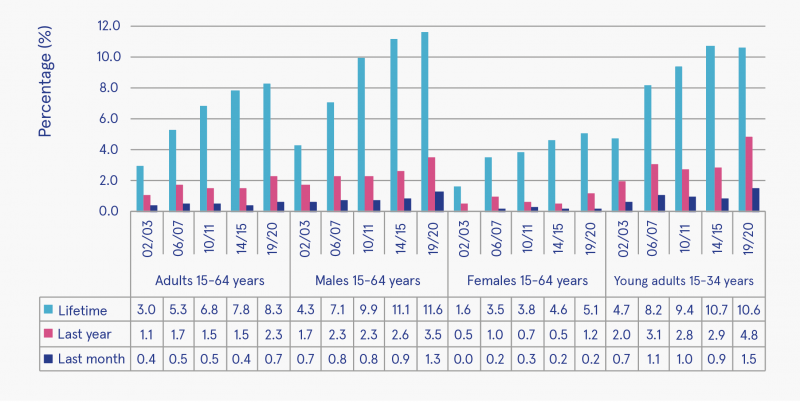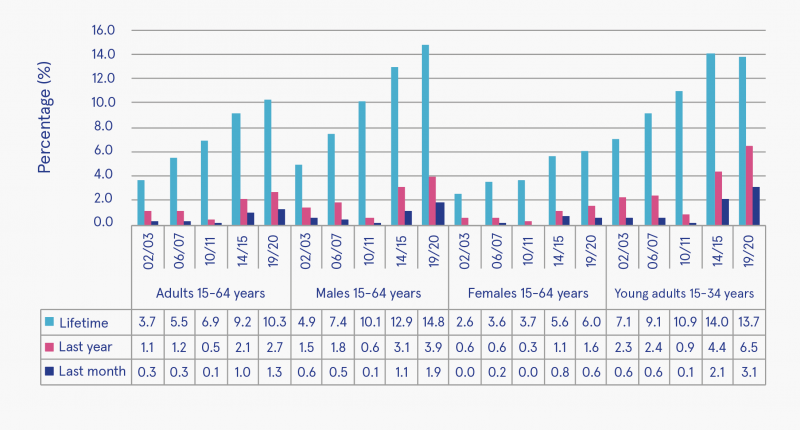Millar, Sean (2021) Results from the fifth general population survey on illicit drug use in Ireland. Drugnet Ireland, Issue 79, Autumn 2021, pp. 1-7.
| Preview | Title | Contact |
|---|---|---|
|
PDF (Drugnet Ireland 79)
1MB |
The first survey on drug use in the general population was carried out in Ireland in 2002/03. The survey was repeated in 2006/07, 2010/11, and 2014/15.1 In 2018, the Health Research Board (HRB) in Ireland commissioned IPSOS MRBI to conduct the fifth Irish National Drug and Alcohol Survey (NDAS).2
Use of any illegal drug
The proportion of respondents aged 15–64 years who reported using any illicit drug in their lifetime has increased from almost 19% in 2002/03 to 27.1% in 2019/20 (see Figure 1). However, lifetime use has stabilised since the last survey. Similarly, last-year and last-month prevalence of any illegal drug use has remained stable since 2014/15; from 8.9% to 9% and 4.7% to 4.9%, respectively. Any illegal drug refers to the use of cannabis, ecstasy, cocaine powder, magic mushrooms, amphetamines, poppers, LSD, new psychoactive substances (NPS), solvents, crack, and heroin.
Illicit drug use was more prevalent in males and also greater among young adults, with 9.8% of persons aged 15–34 years having reported illegal drug use within the previous month (compared to 8.5% in 2014/15). Results from the 2019/20 survey indicated that the most commonly used illicit substances in Ireland, based on last-year prevalence, were cannabis (5.9%), ecstasy (2.2%), and cocaine (1.9%).
Source: NDAS, 2021
Note: Any illicit drug refers to the use of cannabis, ecstasy, cocaine powder, magic mushrooms, amphetamines, poppers, LSD, new psychoactive substances (NPS), solvents, crack, and heroin.
Figure 1: Lifetime, last-year, and last-month prevalence of any illicit drug use in Ireland, 2002/03, 2006/07, 2010/11, 2014/15, and 2019/20
Cannabis use
Findings revealed that 24.4% of the population (15–64 years) had used cannabis at some point in their lives; 7.1% reported use in the year prior to the survey and 3.4% in the preceding month (see Figure 2).
Similar to earlier surveys, rates of cannabis use were greater among men than women: for lifetime use (29.5% vs 19.3%); last-year use (9.9% vs 4.4%); and last-month use (5% vs 2%). Since 2002/03, lifetime, last-year and last-month rates of cannabis use among males have increased by 32.9%, 37.5%, and 47%, respectively. Lifetime and last-year use of cannabis among females has also increased. However, last-month prevalence in women has remained relatively stable over time.
The prevalence of cannabis use was noticeably higher among young adults. However, lifetime and last-month rates were lower than those recorded in 2014/15, while last-year prevalence was unchanged at 13.8%.

Source: NDAS, 2021
Figure 2: Lifetime, last-year, and last-month prevalence of cannabis use in Ireland, 2002/03, 2006/07, 2010/11, 2014/15, and 2019/20
Cocaine use
Lifetime cocaine use has increased when compared with 2014/15 rates (see Figure 3). The percentage of respondents aged 15–64 years who reported using cocaine (including crack) at some point in their lives increased from 7.8% to 8.3%. As was observed in previous surveys, more men reported using cocaine in their lifetime compared with women (11.6% vs 5.1%).
Recent use of cocaine among 15–64-year-olds has increased from 1.1% in 2002/03 to 2.3% in 2019/20, although cocaine use remained stable between 2006/07 and 2014/15. Since the 2014/15 survey, recent cocaine use among males has increased from 2.6% to 3.5%, while use among females has increased from 0.5% to 1.2%. There were also noticeable increases in the use of recent and current use of cocaine among young adults; last-year prevalence has increased from 2.9% in 2014/15 to 4.8% in 2019/20, while current use increased from 0.9% in 2014/15 to 1.5% in 2019/20.

Source: NDAS, 2021
Figure 3: Lifetime, last-year, and last-month prevalence of cocaine use (including crack) in Ireland, 2002/03, 2006/07, 2010/11, 2014/15, and 2019/20
Ecstasy use
Ecstasy was found to be the second most commonly used illegal drug (after cannabis) in the year prior to the survey. With the exception of the 2010/11 survey, recent ecstasy use has increased at each survey; there was a significant decrease in 2010/11 (to 0.5%) but recent use increased to 2.1% in 2014/15 (see Figure 4).
Almost 14% of young adults (15–34 years) said they had tried ecstasy at least once in their lifetime, with 6.5% having used it within the last year (vs 4.4% in 2014/15) and 3.1% indicating current use (vs 2.1% in 2014/15).

Source: NDAS, 2021
Figure 4: Lifetime, last-year, and last-month prevalence of ecstasy use in Ireland, 2002/03, 2006/07, 2010/11, 2014/15, and 2019/20
New psychoactive substances use
Last-year prevalence of NPS use was included as a drug category for the first time in the 2010/11 drug prevalence survey. Findings from the 2014/15 survey demonstrated a reduction in the use of NPS in the Irish population among both genders.
Findings from the 2019/20 NDAS show that the prevalence of recent NPS use remains very low in Ireland, at 0.8% among 15–64-year-olds (compared with 3.5% in 2010/11). This perhaps highlights the continued impact of the Criminal Justice (Psychoactive Substances) Act 2010, which made the sale, import, export, or advertisement of unregulated psychoactive substances for human consumption illegal. The Act also gave appropriate powers to An Garda Síochána and the Courts to intervene quickly to prevent trade in a non-criminal procedure via the use of prohibition and closure orders.
Conclusion
Although results from the 2019/20 NDAS suggest that there has been no change in the prevalence of any recent (last-year) illegal drug use in Ireland since 2014/15, there have been changes regarding the types of drugs used. Importantly, while there has been a small decrease in the prevalence of cannabis use, the use of cocaine and ecstasy has increased.
It should be noted that although opioids were included as a drug category in the 2019/20 drug prevalence survey, the prevalence of heroin use was low, as the NDAS is a general population survey. Thus, persons who do not normally reside in private households have not been included. A national 3-source capture-recapture (CRC) study to provide statistically valid estimates of the prevalence of opiate drug use in the national population was commissioned by the National Advisory Committee on Drugs and Alcohol and undertaken in 20013 and 2006.4 The three data sources used were the Central Treatment List (of clients on methadone), the Hospital In-Patient Enquiry (HIPE) scheme, and Garda PULSE data. A third study using the CRC method was published in 2017.5 In 2020, the HRB awarded a contract to the School of Public Health, University College Cork to conduct a fourth study on the prevalence of opioid use in Ireland for the years 2015–2019 and this research is due to be completed shortly.
1 National Advisory Committee on Drugs and Alcohol and Department of Health (UK) (2016) Prevalence of drug use and gambling in Ireland and drug use in Northern Ireland. Bulletin 1. Dublin: National Advisory Committee on Drugs and Alcohol. https://www.drugsandalcohol.ie/26364/
2 Mongan D, Millar SR and Galvin B (2021) The 2019–20 Irish National Drug and Alcohol Survey: main findings. Dublin: Health Research Board. https://www.drugsandalcohol.ie/34287/
3 Kelly AW, Carvalho M and Teljeur C (2003) Prevalence of opiate use in Ireland 2000–2001: a 3-source capture recapture study. A report to the National Advisory Committee on Drugs Sub-Committee on Prevalence. Dublin: Stationery Office. http://www.drugsandalcohol.ie/5942/
4 Kelly A, Teljeur C and Carvalho M (2009) Prevalence of opiate use in Ireland 2006: A 3-source capture recapture study: a report to the National Advisory Committee on Drugs. Dublin: Stationery Office. http://www.drugsandalcohol.ie/12695/
5 Hay G, Jaddoa A, Oyston J, Webster J, Van Hout MC and Rael dos Santos A (2017) Estimating the prevalence of problematic opiate use in Ireland using indirect statistical methods. Dublin: National Advisory Committee on Drugs and Alcohol. https://www.drugsandalcohol.ie/27233/
B Substances > Cannabis / Marijuana
B Substances > CNS stimulants > MDMA / Ecstasy
B Substances > Cocaine
B Substances > Cocaine > Crack cocaine
B Substances > New (novel) psychoactive substances > Other novel substances > Amyl nitrites (poppers)
VA Geographic area > Europe > Ireland
Repository Staff Only: item control page